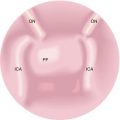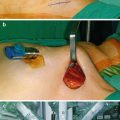Classification
Finding
0
No goiter palpable or visible
1a
Goiter detected by palpation only
1b
Goiter palpable and visible with neck extended
2
Goiter visible with neck in normal position
3
Large goiter visible from a distance
Examination
There is considerable inter- and intra-observer variation regarding size and morphology of the thyroid gland.
The physical examination should focus on inspection of the neck and upper thorax and palpation of the goiter to determine its size and nodularity. The examination should ideally be done with the patient swallowing gulps of water and the head tilted slightly backwards.
Determine character of the thyroid gland: smooth or nodular surface, single or multiple nodules, and soft or hard. Determine if the lower limit of the thyroid gland can be palpated. Get the patient to extend their neck to see if you can get to the lower limit.
Determine indicators of compression (stridor, Pemberton’s sign, thyroid cork and Berry’s sign – see Chap. 20: Surgery for Retrosternal Goiter). Assess the neck and supraclavicular area for enlarged lymph nodes.
Assess if the thyroid gland is fixed or mobile. Mobility on swallowing may be lost in Riedel’s thyroiditis (chronic form of thyroiditis associated with extensive fibrosis) or in anaplastic carcinoma.
Assess vocal cord mobility.
Laboratory Investigations
Serum thyrotropin (TSH) concentration. This should be measured in all patients with thyroid enlargement (British Thyroid Association (BTA) and American Thyroid Association (ATA) guidelines) (British Thyroid Association and Royal College of Physicians 2007; Cooper et al. 2009).
If TSH is low, then serum free triiodothyronine (fT3) and free thyroxine (fT4) concentrations are required to exclude overt hyperthyroidism (raised serum fT4 and fT3 concentrations) or T3 toxicosis (raised serum fT3 concentration alone).
If TSH is raised, then overt hypothyroidism must be excluded (low serum fT4 concentration).
Thyroid dysfunction is rarely associated with malignant disease.
Thyroid autoantibodies. Microsomal, thyroid peroxidase, or TSH receptor antibodies are found in about 10 % of the general population and may coexist with goiter. Levels are elevated in the majority of patients with autoimmune thyroiditis and Graves’ disease. Their presence can alter the interpretation of FNAC and therefore are of importance to the cytopathologist.
Calcitonin. Routine use is not recommended, but it should be performed if medullary thyroid cancer is suspected.
Thyroglobulin. There is no role for the routine measurement of serum thyroglobulin in the initial evaluation of thyroid nodules; however, it is used as a tumor marker following total thyroidectomy and radioiodine ablation for differentiated thyroid cancer.
Flow-Volume Loop Studies
These provide a sensitive and specific measure of upper airway obstruction and thus provide functional information superior to that obtained from routine chest and neck radiography.
Diagnostic Imaging
Ultrasonography (USS) is the most widely used imaging technique in the evaluation of goiters.
USS is highly sensitive and can detect non-palpable nodules. There is a risk of identifying clinically insignificant nodules resulting in unnecessary investigations and associated anxiety for the patient (Hegedus et al. 2003; Hegedus 2001).
USS can estimate the size of nodules and the goiter volume which may be useful in monitoring and assessment of response to treatment.
Some USS characteristics are associated with an increased cancer risk and can be useful when used in conjunction with other investigations. For example, in complex cysts, the appearance of the cyst wall can be described, and solid areas can be targeted for aspiration. Microcalcifications can be seen on USS with coarse calcification usually reflecting colloid nodules and finer calcifications seen in papillary thyroid cancers.
USS is effective at identifying suspicious nodes in 20–30 % of patients with papillary thyroid cancer. It is recommended that a fine needle aspiration of ultrasonographically suspicious lesions is performed.
Scintigraphy
This is a historic investigation for the evaluation of goiters and nodules. It is helpful in assessment of the function of nodules. It has been largely superseded by ultrasonography and fine needle aspiration cytology.
Hot (functional) nodules can be distinguished from cold (nonfunctional) nodules (Hegedus et al. 2003; British Thyroid Association and Royal College of Physicians 2007).
Stay updated, free articles. Join our Telegram channel

Full access? Get Clinical Tree





